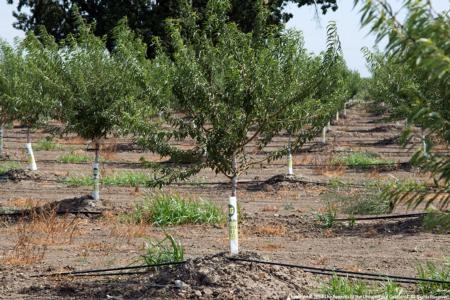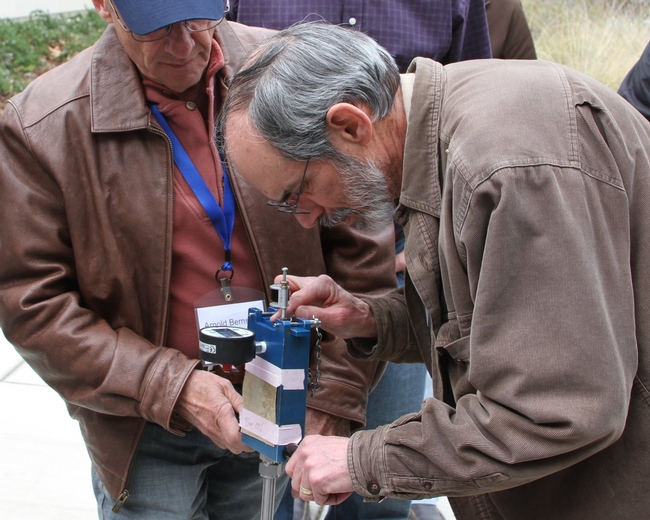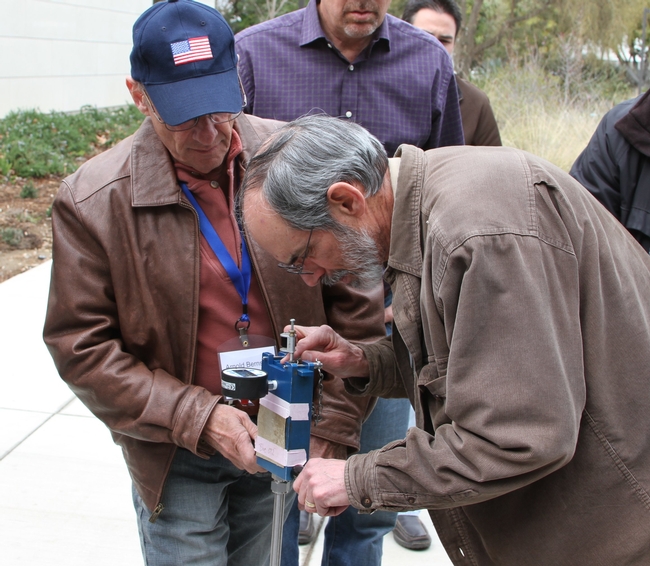Posts Tagged: Ken Shackel
UC scientists share national award for water conservation project
California's ongoing drought has made it even more critical for growers to get the most crop per drop of water used. Scientists from UC Division of Agriculture and Natural Resources and UC Davis and other land-grant universities were recently honored by USDA's National Institute of Food and Agriculture and the Association of Public and Land-Grant Universities for their years of research to help farmers better use microirrigation systems to sustainably irrigate their land.
The 2014 Experiment Station Section Excellence in Multistate Research Award presented by the Experiment Station Committee on Organization and Policy on Nov. 2 recognizes the universities' exceptional collaboration on a multistate research project.
Patrick Brown, professor in the Department of Plant Sciences at UC Davis, Jan Hopmans, professor in the Department of Land, Air and Water Resources at UC Davis, Larry Schwankl, UC Cooperative Extension specialist emeritus, and Ken Shackel, professor in the Department of Plant Sciences at UC Davis, are the UC researchers participating in the project “Microirrigation for Sustainable Water Use.”
"The Multistate Research Program is one of the best kept secrets of the land-grant university system, and this award recognizes outstanding interdependent efforts of researchers and extension specialists that have come together to tackle a priority issue that no one institution can address on their own,” said H. Michael Harrington, executive director of the Western Association of Agricultural Experiment Station Directors. “This microirrigation project was selected out of more than 300 multistate projects because, since 1972, the group has made major advances in sustainable agriculture and water conservation.”
Using more precise irrigation management, California growers have increased water use efficiency on processing tomatoes by 54 percent and on almonds by 33 percent since 1990.
Conventional irrigation systems that apply high volumes of water over wide areas can lose a lot of water through runoff, wind, or evaporation. As a result, conventional irrigation systems often over water or under water plants. Instead, microirrigation, or drip, systems use special timers, sensors, and a network of narrow tubes to deliver the right amount of water at the right time.
In the last five years, the group's research has led to new microirrigation equipment and tools that are easier to install, more durable, and more precise. These advances, along with engagement with farmers, have encouraged adoption of microirrigation systems, which has led to significant economic and environmental impacts.
“As director of USDA-NIFA, my goal is to ensure the science we invest in leads to solutions to today's most pressing challenges,” said Sonny Ramaswamy. “One of those challenges is finding ways to feed the growing population while minimally impacting the environment. A safe, reliable supply of water is inextricably linked to food security. The five-fold increase in irrigated acres that took place during the 20th century cannot be repeated in the 21st century — there isn't the space. Instead, we must increase efficiency of the irrigated farmland we have, and that is what this project is doing.”
In addition to UC, other participating land-grant institutions include Auburn University, University of Arizona, Colorado State University, University of Florida, University of Hawaii, University of Idaho, Iowa State University, Kansas State University, Mississippi State University, University of Nebraska, New Mexico State University, Cornell University, Oregon State University, University of Puerto Rico, Texas A&M AgriLife Research, University of the Virgin Islands, Washington State University, and University of Wyoming. The universities collaborated with the USDA's Natural Resources Conservation Service and Agricultural Research Service.
The award was presented by ESCOP chair Bob Shulstad and Ramaswamy at the Association of Public and Land-Grant Universities annual meeting in Orlando, Fla.
The project's name will be added to a plaque at the USDA Waterfront Centre in Washington, D.C., and the group will receive $15,000 to support their ongoing work. The group's continued efforts are more critical than ever as the U.S. continues to experience extreme droughts that threaten water supplies and crops that depend on irrigation.
These efforts are supported, in part, through USDA-NIFA by the Multistate Research Fund, established in 1998 by the Agricultural Research, Extension, and Education Reform Act (an amendment to the Hatch Act of 1888) to encourage and enhance multistate, multidisciplinary agricultural research on critical issues. Additional funds were provided by contracts and grants to participating scientists. For more information about the microirrigation project, visit http://www.cropinfo.net/MI.
California drought steps-up need for high-tech solutions
With California suffering through the third year of drought, more farmers are turning to technology that will help them make smart irrigation decisions, reported Sarah Shoen in the Fresno Bee.
The story focused on Tom Chandler, a fourth-generation Sanger farmer who uses a pressure chamber to measure the amount of water is in the leaves of his almond trees.
"Using the pressure chambers is like having a fuel gauge for your plants," Chandler said.
For the story, Shoen talked to Allan Fulton, the UC Cooperative Extension irrigation and water resources advisor in Glenn, Colusa and Shasta counties. Fulton has experience with pressure chambers stretching back more than a decade.
"Understanding what the chamber is trying to tell you helps farmers concentrate water in areas that need it the most," Fulton said. "This means more production while using the same amount of water."
The pressure chamber results show farmers whether the crops need water, or if they can get by without water at the moment.
Ken Shackel, professor in the Department of Plant Sciences at UC Davis, learned by conducting research that dry soil doesn't mean the plant is suffering.
"You can save tons of water thanks to the chambers," Shackel said.
UC Fruit and Nut Center website helps growers optimize irrigation
“The website helps growers interpret what their trees and vines are trying to tell them,” said Brooke Jacobs, associate director of the Fruit and Nut Center. “It lets them easily see whether their plants' water-stress levels are normal, or whether they are starting to get thirsty.”
Good water management is vital to crop production, as growers struggle to conserve water, control weeds and make sure nutrients like nitrogen don't get washed away from the orchards they feed. Most growers irrigate when it's hot outside and the soil is dry, which can lead to overwatering.
“Just because the soil is dry, doesn't mean plants are suffering,” explained UC Davis plant physiology professor Ken Shackel, whose research led to routine use of pressure chambers to measure plant water stress in the early 1990s.
Pressure chambers directly measure a plant's water needs by gauging how hard the plant is working to pull moisture from the soil. Researchers and industry leaders promote the use of pressure chambers, and growers who use them often sing their praises.
“Pressure chambers are a fantastic tool for making sure you're watering your trees only when they need it,” said Jerry Sneed, field representative for Crain Ranch, a walnut producing and processing operation in Los Molinas, Calif. “I have total faith in them. They've never steered us wrong.”
“They're great,” agreed Rob Baker, ranch manager at Paramount Farming Co. in Bakersfield, Calif., the world's largest grower and processor of almonds and pistachios. “We've been using them for about 20 years, and we believe they provide the most accurate reading for when to irrigate.”
Still, less than one-third of California growers use pressure chambers to schedule irrigation. As the drought wears on, more growers are making the $1,200 to $3,000 investment in pressure chambers, but some of those new users are having trouble interpreting the water-stress readings.
“All plants will register some level of stress, even when they are fully watered and happy,” said Jacobs, who built the site — “Irrigation Scheduling Using Stem Water Potential Measurements” — along with Shackel and Charlie Turner at UC Davis Academic Technology Systems. “So it can be confusing if you don't know what is considered ‘normal' stress for your plant under similar conditions.”
That's where the website comes in.
As Shackel explained, “Measuring water stress, or what we call stem water potential, at midday is like taking a blood pressure reading during exercise. When the weather is hot and dry, it's normal for the plant to be working harder to pull water, even if the soil is wet. The website calculates stem water potential expected for a plant in wet soil, under the weather conditions for that day. We call that the ‘baseline' value.
“If your tree's stem water potential is close to the baseline value,” Shackel continued, “adding water to the soil won't change how your tree is feeling.”
Another thing: Baseline values vary among species because different plants can handle different levels of stress. “Normal” stress readings for almonds would be considered severe stress for grapes and deadly for walnuts.
To understand all the variables, UC Cooperative Extension advisors provide training and reference charts. This website provides an additional, interactive tool.
“When you enter the date, the time, and the closest weather station, you get a baseline water-stress reading for a similar crop under similar conditions,” Jacobs said. “It takes out all the guesswork, because you can see how thirsty your trees and vines are compared to those in fully wet-soil conditions.”
The new site is good news for growers like Bill Chandler, owner of Chandler Farms in Selma, Calif. He just purchased a pressure chamber to help manage irrigation on his 250 acres of nectarines, plums, grapes and almonds.
“I was always an old-fashioned guy who liked to go out with my shovel and test the dryness of the soil with my hands,” Chandler said. “But if a pressure chamber can improve water management, why not give it a try?”
The website currently provides baseline values for almonds, walnuts, prunes and grapes. With further research, baseline values for other crops may be developed, as well.
Want to see how a pressure chamber works? Here's a video link: http://www.youtube.com/watch?v=8G9DjQxFkkY
You can read more about how pressure chambers operate here: http://fruitsandnuts.ucdavis.edu/pressure_chamber/
The new website is located at this link: http://informatics.plantsciences.ucdavis.edu/Brooke_Jacobs/index.php
For more information, contact the UC Davis Fruit and Nut Research and Information Center at 530-754-9708 or fruitsandnuts@ucdavis.edu
Media contacts:
- Diane Nelson, UC Davis College of Agricultural and Environmental Sciences, 530-752-1969, denelson@ucdavis.edu
- Brooke Jacobs, UC Davis Fruit and Nut Research and Information Center, 530-754-9708, fruitsandnuts@ucdavis.edu



